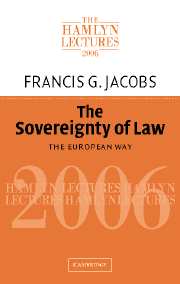Book contents
- Frontmatter
- Contents
- The Hamlyn Trust
- The Hamlyn Lectures
- Preface
- 1 Introduction
- 2 The rule of law in Europe
- 3 The European Convention on Human Rights and the rule of law
- 4 The European Union and the rule of law
- 5 Fundamental values
- 6 Courts and free markets
- 7 The European Union today: some achievements
- 8 The European Union today: some problems
- Afterword
- Index
3 - The European Convention on Human Rights and the rule of law
Published online by Cambridge University Press: 29 July 2009
- Frontmatter
- Contents
- The Hamlyn Trust
- The Hamlyn Lectures
- Preface
- 1 Introduction
- 2 The rule of law in Europe
- 3 The European Convention on Human Rights and the rule of law
- 4 The European Union and the rule of law
- 5 Fundamental values
- 6 Courts and free markets
- 7 The European Union today: some achievements
- 8 The European Union today: some problems
- Afterword
- Index
Summary
The European Convention on Human Rights was drawn up under the auspices of the Council of Europe, the first of the European organizations seeking to build a new European order from the rubble of the Second World War.
The Council of Europe was established in 1949, before even the first of the European Communities. It was symbolically located in Strasbourg, a city which had frequently changed hands between France and Germany in a series of bloody wars, culminating in the two World Wars of the twentieth century.
The preamble to the Statute of the Council of Europe refers to shared spiritual and moral values. The contracting States reaffirm ‘their devotion to the spiritual and moral values which are the common heritage of their peoples and the true source of individual freedom, political liberty and the rule of law, principles which form the basis of all genuine democracy’.
By Article 3 of the Statute, every member State of the Council of Europe ‘must accept the principles of the rule of law and of the enjoyment by all persons within its jurisdiction of human rights and fundamental freedoms’. By Articles 7 and 8 of the Statute, a member State which seriously violates Article 3 may be suspended from the Council of Europe, and ultimately expelled. These provisions had no parallel in the history of international organizations.
- Type
- Chapter
- Information
- The Sovereignty of LawThe European Way, pp. 18 - 34Publisher: Cambridge University PressPrint publication year: 2007



